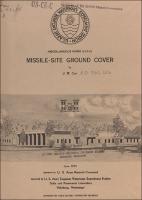Please use this identifier to cite or link to this item:
https://hdl.handle.net/11681/20950| Title: | Missile-site ground cover |
| Authors: | United States. Army Materiel Command Carr, James W. |
| Keywords: | Dust control Ground covers Missile sites Honest John (Rocket) Missile launching sites Rocket launching Protective coverings Blast effects |
| Publisher: | Soils and Pavements Laboratory (U.S.) Engineer Research and Development Center (U.S.) |
| Description: | Miscellaneous Paper Abstract: Experience with Army tactical rockets and missiles has shown that, during launchings over unprotected soil surfaces, the motor blast produces dust clouds that can reveal the firing location to the enemy and cause soil erosion in the launch area that is detrimental to reloading and operating conditions. Since the tactical missiles and rockets are highly mobile, the need exists for lightweight, flexible ground covers to enable rapid deployment and easy transporting. Tests were conducted at the U.S. Army Engineer Waterways Experiment Station (WES) in which small rocket motors were fired onto flexible, blast-resistant silicone rubber specimens at exposure temperatures of 3800°F. The results of these tests were used to select the most suitable material for field testing. A prototype ground cover of the most promising materials was fabricated at WES. The ground cover consisted of silicone rubber applied to a woven glass fabric; the weight of this cover was 9 lb per sq yd. The missile-site ground cover was taken to White Sands Missile Range, where it was installed and blast-tested using the Honest John rocket. The results of this field investigation showed that a ground cover fabricated of the glass fabric coated with the silicone rubber would withstand the direct blast of the Honest John rocket engine. Additional prototype tests should be conducted to determine the number of firings the cover can withstand and the areal extent of ground protection required for dust alleviation. Also, efforts should be made to reduce the weight of the cover without sacrificing strength and performance. Such a ground cover can also serve to camouflage the rocket and to protect the rocket from adverse weather conditions when not in use as ground cover. NOTE: This file is large. Allow your browser several minutes to download the file. |
| Rights: | Approved for public release; distribution is unlimited. |
| URI: | http://hdl.handle.net/11681/20950 |
| Appears in Collections: | Miscellaneous Paper |
Files in This Item:
| File | Description | Size | Format | |
|---|---|---|---|---|
| MP-S-73-35.pdf | 59.21 MB | Adobe PDF |  View/Open |